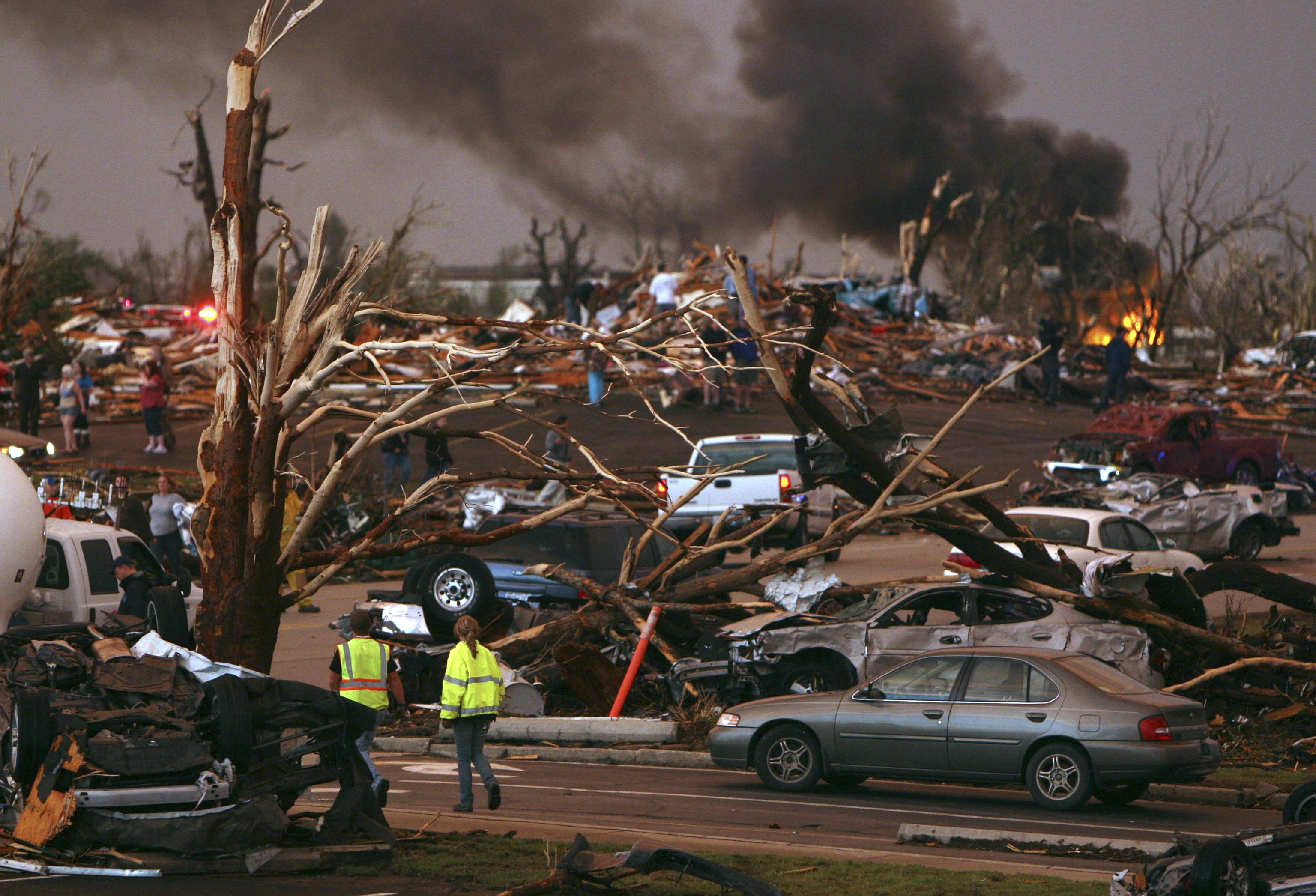 Emergency personnel walk through a severely damaged neighborhood after a tornado hit Joplin, Mo. In 2011 the United States saw one of the busiest tornado seasons in generations: Nearly 1,700 tornadoes that killed 553 people. With the planet heating up, many scientists seem fairly certain some weather elements like hurricanes and droughts will worsen. But as the traditional season nears, scientists are still trying to figure out if there be more or fewer tornadoes as global warming increases.
Emergency personnel walk through a severely damaged neighborhood after a tornado hit Joplin, Mo. In 2011 the United States saw one of the busiest tornado seasons in generations: Nearly 1,700 tornadoes that killed 553 people. With the planet heating up, many scientists seem fairly certain some weather elements like hurricanes and droughts will worsen. But as the traditional season nears, scientists are still trying to figure out if there be more or fewer tornadoes as global warming increases.OKLAHOMA CITY - With the planet heating up, many scientists seem fairly certain some weather elements like hurricanes and droughts will worsen. But tornadoes have them stumped.
These unpredictable, sometimes deadly storms plague the United States more than any other country. Here in tornado alley, Oklahoma City has been hit with at least 147 tornadoes since 1890.
But as the traditional tornado season nears, scientists have been pondering a simple question: Will there be more or fewer twisters as global warming increases?
There is no easy answer. Lately, tornado activity in America has been Jekyll-and-Hyde weird, and scientists are unsure if climate change has played a role in recent erratic patterns.
In 2011, the United States saw its second-deadliest tornado season in history: Nearly 1,700 tornadoes killed 553 people. The Joplin, Mo., twister was the single deadliest in American history, killing 158 people and causing $2.8 billion in damage.
The following year, 2012, started even earlier and even busier. Through April there were twice as many tornadoes as normal. Then the twisters suddenly disappeared. Tornado activity from May to August of that year was the lowest in 60 years of record-keeping, said Harold Brooks, a top researcher at the National Weather Center in Norman, Okla.
Meanwhile, Canada saw an unusual number of tornadoes in 2012; Saskatchewan had three times the normal number.
That year, the jet stream moved north and "essentially shut down" tornadoes in the American Midwest said Greg Carbin, warning meteorologist at the federal storm center. A tremendous drought meant far fewer storms, which not only shut off the spigot on rain but on storm cells that spawned tornadoes.
For much of America, tornadoes are seasonal. Typically, there are more during spring, and the numbers dwindle in the worst heat of the summer. Last year "essentially was an extended period of summertime conditions over the U.S.," Carbin said. "The real question is: What is spring now? Is it February?"
"Summer may be happening earlier and may be muscling out what we consider a transition between summer and winter," he said.
The last two seasons aren't alone in illustrating extremes in tornado activity.
Tornado record-keepers tally things like the most and least tornadoes in a month. Records for that category have been set 24 times over the past 60 years. Ten of those records have been set in the past decade - six for the fewest tornadoes and four for the most, Brooks said. Also, the three earliest starts of tornado season and the four latest have all occurred since 1997, he said.
What does that mean?
"We've had a dramatic increase in the variability of tornado occurrence," Brooks said.
The jet stream, a major player in tornado formation, has been in a state of flux, varying wildly in recent years, said Pennsylvania State University climate scientist Michael Mann.
"It's hard to predict future tornado seasons when we don't understand current tornado seasons," Brooks said between sessions at the National Tornado Summit here earlier this week. "We're not sure what's going to happen with the tornado numbers."
A new study in the Bulletin of the American Meteorological Society looks at all sorts of extreme weather, how it is changing because of global warming and how things are predicted to change in the future. The study says tornadoes and the severe thunderstorms that spawn them are the hardest to predict.
Public opinion polls show Americans blame global warming for bad tornado outbreaks, but climate scientists say that's not quite right.
One reason scientists can't figure out how global warming might affect tornadoes is that twisters are usually small weather events that aren't easily simulated in large computer models. And records of tornadoes may not have been accurate over the years as twisters twirled unnoticed around unpopulated areas.
So Brooks and others are looking at the ingredients that cause tornadoes. But even that isn't simple. They look at two main factors: moist energy in the atmosphere and wind shear. Wind shear is the difference between wind at high altitudes and wind near the surface. The more moist energy and greater the wind shear, the better the chances for tornadoes.
The atmosphere can hold more moisture as it warms, and it will likely be more unstable so that means more moist energy, several experts said. But wind shear is another matter. Brooks and Stanford University scientist Noah Diffenbaugh think there will be less of that.
That would suggest fewer tornadoes. But if there's more moist energy, that could lead to more tornadoes. One ingredient has to win out, and Brooks says it's hard to tell which one will. Diffenbaugh says recent computer simulations show the moist energy may overcome the reduced shear and produce at least more severe thunderstorms, if not tornadoes.
Given what's happening lately, Brooks believes there will be fewer days of tornadoes but more twisters on the days when they occur.
